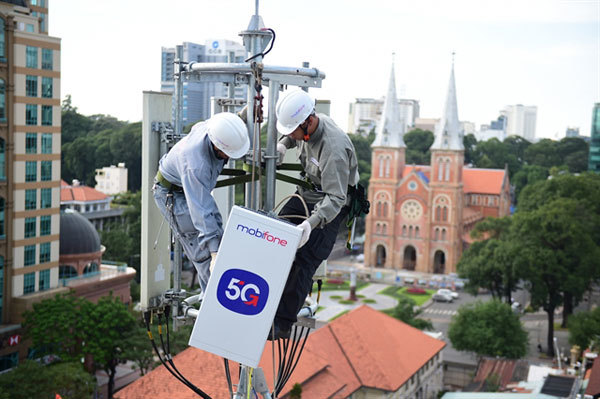Minister of Information and Communications Nguyen Manh Hung said that the Government would sign a decree on frequency auctions in the fourth quarter so that the ministry could grant 4G/5G frequencies for operators to invest in increasing capacity and especially 5G coverage next year.
 |
| MobiFone's staffs install 5G equipment. — Photo courtesy of MobiFone |
The minister also noted that the country's digital infrastructure strategy aimed to rank in the Top 30 in the world before 2025, so that businesses in Vietnam would have modern digital infrastructure to develop the digital economy. Vietnam also set a target of 100 per cent of people using smartphones by 2023.
Previously, according to the Ministry of Information and Communications, during the implementation of the 2.6 GHz band auction, legal documents such as the Law on Property Auction and the Law on Public Property Management must be applied, so it was necessary for the auction of the right to use frequency to review the order and procedures in accordance with the new regulations.
In addition, the determination for the starting price for this band is also difficult because this is the first time Vietnam has auctioned the right to use radio frequencies (an intangible asset), while Decision 16/2012/QĐ-TTg only stipulates the principle of determining the price, not specifying the specific method of determining the starting price.
In Vietnam, all three major carriers, Viettel, VNPT, and MobiFone are testing 5G and waiting for this frequency auction to officially provide services.
According to the General Statistics Office, Vietnam is one of the three Asian countries with positive growth, the size of the economy is more than US$343 billion while Singapore reached $337.5 billion and Malaysia reached $336.3 billion.
The Vietnamese government identifies one of the pillars of the digital economy as telecommunications infrastructure, including both mobile and fixed broadband infrastructure.
In fact, the development of broadband infrastructure has paved the way for all other economic sectors to develop in just the past three years.
Deputy Minister of Information and Communications Phan Tam said that the world would continue to witness great transformations of human society in the next 10 years.
They are the transition from the real world to the virtual world, the transformation of all socio-economic activities into the digital environment, data to become an important resource of each country and the development of the country and strong development of IoT connectivity.
In Vietnam, according to research by the National Institute of Information and Communications Strategy, the contribution rate of 5G to GDP growth is forecast to reach 7.34 per cent by 2025.
Therefore, the socio-economic development strategy in the 2021-2030 period and the socio-economic development plan for the 2021-2025 period have repeatedly mentioned digital transformation, telecommunications, IT, digital technology, digital government, and digital skills.
In that context, the Ministry of Information and Communications determines to go with the world and take the initiative in deploying 5G commercialisation in Vietnam.
Source: Vietnam News

4G/5G frequency licenses to be granted to VN network operators soon
A decree on frequency auctioning is expected to be signed in the fourth quarter that will enable the Ministry of Information and Communications (MIC) to grant 4G/5G frequencies to telecom carriers.